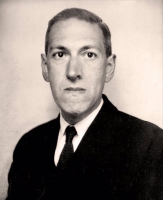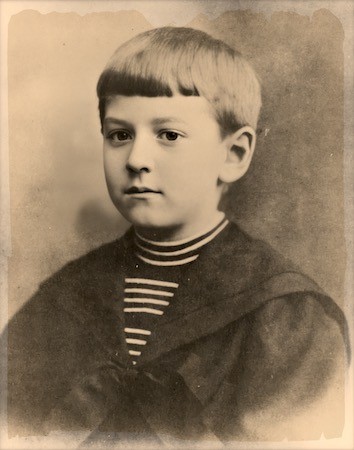| |
霍华德·菲利普斯·洛夫克拉夫特(英语:Howard Phillips Lovecraft,1890年8月20日-1937年3月15日)是美国恐怖,科幻与奇幻小说作家,尤以其怪奇小说著称。
洛夫克拉夫特自称其写作的主题为“宇宙主义”,这一主题的基本概念为:人类有限的心智无法理解生命的本质,而宇宙对于人类来说是残酷陌生的。洛夫克拉夫特通过一系列围绕着非人诸神主题展开的关联松散的小说开发出克苏鲁神话体系;同一时期他还在作品中设定出了《死灵之书》,一本关于魔法仪式及失落知识的虚构魔法书。洛夫克拉夫特的作品大多包含悲观与愤世嫉俗的情感,与启蒙思想、浪漫主义以及基督教人文主义的价值观格格不入。
虽然洛夫克拉夫特的名气在他在世时一直很低,但在死后其名声却日益高涨;今天,洛夫克拉夫特被视为二十世纪最具影响力的恐怖小说家之一。根据乔伊斯·卡罗尔·欧茨所说,洛夫克拉夫特—以及19世纪的埃德加·爱伦·坡—“对后世恐怖小说家施加了无可估量的影响。” 斯蒂芬·金称洛夫克拉夫特是“20世纪最伟大的古典恐怖故事作家。”
生平
早年生活
洛夫克拉夫特于1890年8月20日早上9点出生在美国普罗维登斯安格尔街194号(现454号)的家宅里。他是珠宝推销员温菲尔德·斯科特·洛夫克拉夫特(Winfield Scott Lovecraft)与其妻莎拉·苏珊·菲利普斯·洛夫克拉夫特(Sarah Susan Phillips Lovecraft)的独生子。可追溯到的母系祖先于1630年抵达马萨诸塞湾殖民地。他的父母在30岁左右才成婚,且双方都是初次结婚,这在当时并不常见。1893年,洛夫克拉夫特三岁时,他的父亲在推销旅行途中于芝加哥的一家旅馆精神失常,其后被送往普罗维登斯的巴特勒医院;老洛夫克拉夫特在那里一直待到1898年过世。洛夫克拉夫特一生都坚称父亲发疯的原因是工作过度引起的“神经衰弱”,但是现代观点认为其父失常的真正原因是麻痹性痴呆(Paralytic dementia)。洛夫克拉夫特到底是否了解父亲的疾病及其真正成因(梅毒),今天已无从稽考,但他的母亲很可能曾使用过含砷的酊剂(当时治疗梅毒的常用药物)作为“预防药物”。
在父亲住院后,洛夫克拉夫特由母亲、两个姨母(莉莉安·德萝拉·菲利普斯与安妮·埃米丽妮·菲利普斯,Lillian Delora Phillips & Annie Emeline Phillips)以及商人外祖父惠普尔·范·布伦·菲利普斯(Whipple Van Buren Phillips)照看,五人住在一间屋子里。洛夫克拉夫特小时候就表现出与众不同的文学天赋,他三岁时即能背诵诗歌,六岁时已能写出完整的诗篇。他的外祖父经常给他一些文学经典鼓励他阅读(如《一千零一夜》,布尔芬奇的《神话时代》,还有儿童版本的《伊利亚特》与《奥德赛》)。他的外祖父也时常向洛夫克拉夫特讲述一些自编的哥特式恐怖故事,这引起了他对怪奇小说的兴趣。不过,洛夫克拉夫特的母亲时常担心这些故事会给他带来不良影响。
洛夫克拉夫特童年时经常患病,虽然他总是将原因归咎于自己身体孱弱,但其中有一些疾病可以肯定为心身疾病。早前的猜测认为他在胎儿时从父母处感染了梅毒,但这种看法现已被摒弃。由于身体状况和好斗的天性,洛夫克拉夫特在八岁前基本没有接受过学校教育,八岁时入学一年后又旋即退学。这一时期他广泛地阅读各类书籍,对化学和天文学展现了浓厚的兴趣。他于1899年起自己编辑出版了几期胶版印刷刊物《科学公报》(The Scientific Gazette)。四年后,他进入当地的霍普街高中(Hope Street High School)就读。一般认为洛夫克拉夫特早年患有夜惊(一种睡眠疾病);他相信自己曾被恐怖的“暗夜幽灵”袭击过。他很多作品的灵感可能都来自于这一时期受到的惊吓。
1904年,洛夫克拉夫特的外祖父去世,这场变故彻底地改变了他的生活。对他外祖父遗产的处理失当导致其家庭陷入财务危机,一家人不得不搬往安格尔街598号(现为联式房屋,598-600号)的一间小屋子里。失去故宅对他的打击非常大,当时的洛夫克拉夫特甚至曾考虑过自杀。1908年,在他高中毕业前夕,洛夫克拉夫特经历了一场“精神崩溃”(据洛夫克拉夫特自述),他最终没有获得高中文凭(尽管他一直坚称自己高中毕业)。S·T·乔希在洛夫克拉夫特的传记里认为他崩溃的主要原因是无法学好高等数学,而不精通这一科目的话他又无法成为理想中的职业天文学家。即使在洛夫克拉夫特往后的生活中,这一求学路上(他希望能入读布朗大学)的失败仍使他无法释怀。
1919年,洛夫克拉夫特的母亲在受歇斯底里和抑郁症的长期折磨后被送往她丈夫曾住过的巴特勒医院。她在医院时仍与洛夫克拉夫特保持通信,直到她在1921年5月21日去世前,两人的关系依旧十分亲密。母亲的离世又给洛夫克拉夫特带来巨大的打击。
婚姻与纽约生活
母亲去世后数月,洛夫克拉夫特前往波士顿参加一次业余记者集会,会上他遇见了索尼娅·格林。索尼娅出生于1883年,比洛夫克拉夫特年长7岁,她的祖先是乌克兰裔犹太人。两人于1924年结婚,婚后移居至纽约布鲁克林。洛夫克拉夫特的姨母们对这场婚姻不甚满意,因为她们不希望洛夫克拉夫特娶一个商人为妻(索尼娅开有一间帽店)。婚姻伊始,洛夫克拉夫特被纽约的生活彻底迷住,但很快夫妇两人就遇到了财务危机。索尼娅变卖了帽店,其后又出现了健康问题。由于洛夫克拉夫特的薪水不足供两人开销,他的妻子不得不搬到克利夫兰求职。此后洛夫克拉夫特独自一人住在布鲁克林的雷德胡克社区,逐渐对纽约生活起了厌恶之情。而在移民大潮中无法找到任何工作这一严峻的现实,与他对自身盎格鲁-撒克逊人血统的认同相抵触,这激起了他的种族主义观点,具体体现在了他的短篇故事《雷德胡克恐怖事件》(The Horror at Red Hook)之中。
在分居数年后,洛夫克拉夫特和妻子决定平静地离婚,但这一过程始终没有彻底完成。此后他回到了普罗维登斯,和自己的姨母们住在一起。
重返普罗维登斯
重返普罗维登斯后,洛夫克拉夫特住在巴恩斯街10号一间“宽敞的棕色木构维多利亚式房屋”里。这里也是其小说《查尔斯·迪克斯特·瓦德事件》中威利特博士的住址。回到普罗维登斯后的十年(也是他生命的最后十年)是洛夫克拉夫特一生中最多产的时期。几乎所有他为通俗出版物(主要是《诡丽幻谭》)所写的知名短篇故事都出自这一时期;他在这一时期的长篇作品也同样丰富,如《查尔斯·沃德·德克斯特事件》与《疯狂山脉》等等。他还经常替其他作家修改文章或是代笔写作,这一类作品包括《坟丘》(The Mound),《飞来横祸》(Winged Death),还有《金字塔之下》(又名《与法老同囚》)(与哈利·胡迪尼合著)等。 洛夫克拉夫特在表面上看来是个传统的保守主义者,但他却自认是“新政民主党人”,他还是富兰克林·罗斯福的坚定追随者。
尽管在此一时期洛夫克拉夫特杰作不断,但他的经济状况却越来越拮据。他不得不搬到姨母家寄宿。同时他还受到友人罗伯特·欧文·霍华德(蛮王柯南系列作者)自杀的打击。1936年,洛夫克拉夫特被确诊患上了肠癌。他受病痛折磨直到于1937年3月15日去世。
洛夫克拉夫特和他父母一起葬于菲利普斯家族墓地。1977年,他的一个读者团体出资为他在天鹅角(Swan Point)重修了一座坟墓,墓碑上刻了洛夫克拉夫特的姓名、出生与死亡日期,以及一句话:“I AM PROVIDENCE”(双关语,可译为“我是普罗维登斯人”或“吾乃天命之人”),这句话出自他的私人信件。
创作背景
H·P·洛夫克拉夫特这个名字在今天已经成为了恐怖小说的同义词。他的著作,尤其是他的“克苏鲁神话”,影响了全世界的小说作家;洛夫克拉夫特式的恐怖元素曾出现在各种小说、电影、漫画(例如蝙蝠侠系列里的阿卡姆疯人院)、音乐、游戏甚至是动画里。许多现代恐怖作家,包括斯蒂芬·金、本特利·利特、乔·R·兰斯代尔、艾伦·摩尔、伊藤润二、弗朗西斯·保罗·威尔逊与尼尔·盖曼,都曾受洛夫克拉夫特的影响。
虽然洛夫克拉夫特的很多作品都发表在像《诡丽幻谭》这样的流行杂志上,但于有生之年他的知名度一直不高。此外,他一直和一些同时代的作家保持通信,例如与他成为朋友的克拉克·阿什顿·史密斯与奥古斯特·德雷斯。这些作家后来形成了“洛夫克拉夫特作家圈”,他们经常从洛夫克拉夫特的故事中借用惊悚元素——比如说拥有令人不安的名字的神秘书籍,失落的古代众神——如克苏鲁及阿撒托斯,还有怪异的地方——例如新英格兰的阿卡姆镇和米斯卡塔尼克大学。
洛夫克拉夫特死后,洛夫克拉夫特作家圈的活动仍在继续。奥古斯特·德雷斯是其中最为多产的一位,他进一步完善了克苏鲁神话的体系。但德雷斯的创作却引起了争议;洛夫克拉夫特自己一直将笔下的诸神作为推动情节发展的要素,但德雷斯创造了一个完整的宇宙体系,描绘了发生在‘善良的’“古神”与‘邪恶的’“外神”之间的战争,给克苏鲁神话带来了传统的善恶斗争元素。
洛夫克拉夫特的创作被一些评论家分成三个时期。尽管洛夫克拉夫特自己并没有提过这种分类,但他确实曾写过,“这是我的‘坡’部分还有‘邓萨尼’部分——不过哎呀——洛夫克拉夫特部分哪去了?”
一些评论家认为幻梦神话和克苏鲁神话之间的差别并不大,尤其显著的是两者都涉及了神秘的《死灵之书》以及克苏鲁诸神。不过幻梦神话比较接近奇幻小说的范畴,而克苏鲁神话则更像科幻作品。此外,幻梦神话的故事大多发生在异世界里,而克苏鲁神话则与人类生活的世界有着许多交集。
所受影响
影响过洛夫克拉夫特的作家包括格特鲁德·贝内特(Gertrude Barrows Bennett,笔名弗朗西斯·史蒂文斯,Francis Stevens,洛夫克拉夫特曾公开赞誉过她,并最终开始“模仿贝内特的早期写作风格”),奥斯瓦尔德·斯宾格勒,罗伯特·钱伯斯(著有《黄衣之王》,洛夫克拉夫特在给克拉克·阿什顿·史密斯的一封信里曾说:“钱伯斯就像鲁珀特·休斯(Rupert Hughes)和倒下的泰坦巨人们一样,他们拥有良好的头脑和教育,却不懂得怎样使用它们。”),亚瑟·玛臣(著有《大潘神》),邓萨尼勋爵(《佩加纳诸神》以及其他作品),埃德加·爱伦·坡,亚伯拉罕·格雷斯·梅里特(《月池》以及基于前书的《金属怪物》)以及洛夫克拉夫特的朋友罗伯特·欧文·霍华德和克拉克·阿什顿·史密斯。
洛夫克拉夫特认为最适合自己的时代是18世纪早期。他的写作风格,尤其体现在他的信件中,与启蒙时代的奥古斯都风格作家约瑟夫·艾迪生与乔纳森·斯威夫特等人非常相似。他甚至还在文章中使用了不少这一文学时期的特殊语法。虽然洛夫克拉夫特的小说主题和启蒙运动所主张的人类可以用理性探求宇宙一概念相抵触,但从洛夫克拉夫特的私人信件看来,他相当支持同时代的理性主义者,例如伯特兰·罗素。
他曾在小说《克苏鲁的呼唤》开头引用过阿尔杰农·布莱克伍德的小说《半人马》(The Centaur);并说过布莱克伍德的《柳林》(The Willows)是有史以来最好的怪奇小说。
洛夫克拉夫特的其他私人藏书还包括列昂尼德·尼古拉耶维奇·安德列耶夫所著的《七个被绞死的人》(The seven who were hanged)与詹姆斯·德·米勒(James De Mille)所著的《铜柱中发现的奇怪手稿》(A Strange Manuscript Found in a Copper Cylinder)。
文化影响
洛夫克拉夫特和他的故事对后世文化有着不可估量的影响,他本人也受过许多现代作家的盛赞。相当多与他同时代的人物,包括他的朋友与同事,如奥古斯特·威廉·德雷斯,罗伯特·欧文·霍华德,罗伯特·布洛克和弗里茨·莱伯等,都受过他的直接影响。许多后世人物也受到了洛夫克拉夫特的影响,当中包括视觉艺术家克里夫·巴克,恐怖小说家斯蒂芬·金,漫画作家艾伦·摩尔与尼尔·盖曼,电影导演约翰·卡彭特,斯图尔特·戈登,吉尔摩·德尔·托罗,恐怖漫画家伊藤润二,以及艺术家汉斯·鲁道夫·吉格尔。2007年,作家格兰特·考格斯威尔(Grant Cogswell),导演丹尼尔·格尔达克(Daniel Gildark)及演员贾森·科特尔(Jason Cottle),托蕊·斯培林(Tori Spelling)等人制作了电影《克苏鲁》,这部电影是对《克苏鲁的呼唤》的再创作,把小说背景移到了太平洋西北地区。
阿根廷作家豪尔赫·路易斯·博尔赫斯写了一个短篇故事《余事未了》(There Are More Things)纪念洛夫克拉夫特。当代法国作家米歇尔·维勒贝克(米歇尔·维勒贝克)则为其著有一本名为《H·P·洛夫克拉夫特:对抗世界,对抗生活》(H. P. Lovecraft: Against the World, Against Life)的文学传记。美国作家乔伊斯·卡罗尔·欧茨曾为洛夫克拉夫特的短篇故事集作了引言。美国书库在2005年出版了洛夫克拉夫特文集,在实质上承认了他为美国经典作家。
作品
相关地点
洛夫克拉夫特在小说中广泛地使用他的家乡新英格兰作为背景。他的书中出现过大量真实存在的地点,但也有一些是虚构的。
真实地点
- 罗得岛州帕斯科格,出现在《雷德胡克恐怖事件》中
- 罗得岛州切帕奇特,出现在《雷德胡克恐怖事件》中
- 佛罗里达州盖恩斯维尔,出现在短篇故事《伦道夫·卡特的自述》中
- 俄克拉何马州卡多县宾格镇,出现在《坟丘》中
- 马萨诸塞州考普山
- 罗得岛州波塔克西特(现名克兰斯顿)
- 马萨诸塞州纽伯里波特
- 马萨诸塞州伊普斯威奇
- 马萨诸塞州博尔顿
- 马萨诸塞州塞勒姆
- 佛蒙特州伯瑞特波罗
- 纽约州奥尔巴尼
- 位于普罗维登斯的许多真实地点,如哈尔西宅邸(Halsey House),展望台(Prospect Terrace)以及布朗大学。
- 丹弗斯州立医院,位于马萨诸塞州丹弗斯。
- 卡兹奇山
- 纽约
虚构地点
- 米斯卡塔尼克大学,位于虚构的小镇马萨诸塞州阿卡姆
- 马萨诸塞州敦威治
- 马萨诸塞州印斯茅斯
- 马萨诸塞州金斯波特
- 马萨诸塞州艾尔斯伯里
- 马丁滩
- 米斯卡塔尼克河
- 真实存在的布宜诺斯艾利斯大学中虚构的中央图书馆。据洛夫克拉夫特小说所述这里保存着《死灵之书》的副本。
附注
- ^ Wilson, Colin. The Strength to Dream: Literature and the Imagination. : 8. ISBN 1600250203.
He hated modern civilization, particularly its confident belief in progress and science.
- ^ H.P. Lovecraft in Popular Culture by Don G. Smith, 2005, ISBN 978-0-7864-2091-9,page 85, "Lovecraft never had much good to say about families either"
- ^ Joyce Carol Oates. The King of Weird. The New York Review of Books. October 31, 1996, 43 (17) [2009-02-15].
- ^ King quoted on front cover of 1982 paperback edition of The Best of H.P. Lovecraft: Bloodcurdling Tales of Horror and the Macabre published by Del Rey Books with introduction by Robert Bloch. Other sources quote King as calling this judgement of Lovecraft "undeniable" or "beyond doubt."
- ^ Wohleber, Curt. The Man Who Can Scare Stephen King (volume 46, issue 8). American Heritage Magazine. December 1995.
- ^ Luc Sante, "The Heroic Nerd", in The New York Review of Books, October 10, 2006
- ^ This situation is closely paralleled in the semi-autobiographical "He", as noted by Michel Houellebecq in 'H. P. Lovecraft: Against the World, Against Life
- ^ H. P. Lovecraft: Against the World, Against Life, Michel Houellebecq
- ^
- ^ James Turner (ed.). Tales of the Cthulhu Mythos 1st ed. New York, NY: Random House. 1998. cover blurb. ISBN 0-345-42204-X.
- ^ Letter to Elizabeth Toldridge, March 8, 1929, quoted in Lovecraft: A Look Behind the Cthulhu Mythos
- ^ "The Woman Who Invented Dark Fantasy" by Gary C. Hoppenstand from Nightmare and Other Tales of Dark Fantasy by Francis Stevens, University of Nebraska Press, 2004, page xiv. ISBN 978-0-8032-9298-7
- ^ Partners in Wonder: Women and the Birth of Science Fiction, 1926-1965 by Eric Leif Davin, Lexington Books, 2005, pages 409-10.
- ^ Selected Letters IV, page 390
- ^ A. Merritt's The Metal Monster, Skulls in the Stars, February 2, 2009
- ^ In this essay Lovecraft calls W.H. Hodgeson the second best writer of weird fictions behind Blackwood. Later, he says Blackwood's best work is "The Willows". Gaslight.mtroyal.ca. 1988-01-01 [2010-03-10].
- ^ Giger, Hansruedi (2005): Necronomicon I & II. Erftstadt: Area.
- ^ H. P. Lovecraft. H.P Lovecraft: Tales (The Library of America). Loa.org. [2010-03-10].
- ^ The Horror, the Horror!. The Weekly Standard. 2005-03-07 [2010-03-10].
- ^ Kenney, Michael. The Library of America scares up a collection of Lovecraft's local lore — The Boston Globe. Boston.com. 2005-02-15 [2010-03-10].
参考书目
- The Strange Sound of Cthulhu: Music Inspired by the Writings of H. P. Lovecraft ( ISBN 978-1-84728-776-2), written by Gary Hill
- Lovecraft: Disturbing the Universe (ISBN 978-0-8131-1728-7), by Donald R. Burleson, PhD, a longtime scholar on Lovecraft and acquaintance of S. T. Joshi, is probably the only book analyzing Lovecraft's literature from a deconstructionist standpoint. University Press of Kentucky, November 1990.
- The Gentleman From Angell Street: Memories of H. P. Lovecraft ( ISBN 978-0-9701699-1-4), written by Muriel and C. M. Eddy, Jr. is a collection of personal remembrances and anecdotes from two of Lovecraft's closest friends in Providence. The Eddys were fellow writers, and Mr. Eddy was a frequent contributor to Weird Tales.
- Lovecraft: A Look Behind the Cthulhu Mythos (ISBN 978-0-586-04166-6), written by Lin Carter in 1972, is a survey of Lovecraft's work (along with that of other members of the Lovecraft Circle) with considerable information on his life.
- The Rise and Fall of the Cthulhu Mythos by S.T. Joshi (Mythos Books, 2008) is the first full-length critical study since Lin Carter's to examine the development of Lovecraft's Mythos and its outworking in the oeuvres of various modern writers.
- The first full-length biography was Lovecraft: a Biography (ISBN 978-0-345-25115-2), written by L. Sprague de Camp; published in 1975, it is now out of print.
- Frank Belknap Long's Howard Phillips Lovecraft: Dreamer on the Nightside (Arkham House, 1975, ISBN 978-0-87054-068-4) presents a more personal look at Lovecraft's life, combining reminiscence, biography, and literary criticism. Long was a friend and correspondent of Lovecraft, as well as a fellow fantasist who wrote a number of Lovecraft-influenced Cthulhu Mythos stories (including The Hounds of Tindalos).
- A newer, more extensive biography is H. P. Lovecraft: A Life (ISBN 978-0-940884-88-5) written by Lovecraft scholar S. T. Joshi. An alternative is Joshi's abridged A Dreamer & A Visionary: H. P. Lovecraft in His Time (ISBN 978-0-85323-946-8). An unabridged reprint in two volumes of Joshi's biography is forthcoming in 2010 from Hippocampus Press.
- An English translation of Michel Houellebecq's H. P. Lovecraft: Against the World, Against Life (ISBN 978-1-932416-18-3) was published by Believer Books in 2005.
- Other significant Lovecraft-related works are An H. P. Lovecraft Encyclopedia by Joshi and David S. Schulz; Lovecraft's Library: A Catalogue (a meticulous listing of many of the books in Lovecraft's now scattered library), by Joshi; Lovecraft at Last, an account by Willis Conover of his teenage correspondence with Lovecraft; Joshi's A Subtler Magick: The Writings and Philosophy of H. P. Lovecraft.
- Andrew Migliore and John Strysik's Lurker in the Lobby: The Guide to the Cinema of H. P. Lovecraft and Charles P. Mitchell's The Complete H. P. Lovecraft Filmography both discuss films containing Lovecraftian elements.
- Lovecraft's prose fiction has been published numerous times. The "corrected texts" were released by Arkham House in the 1980s, and many other collections of his stories have appeared, including Ballantine Books editions and three popular Del Rey editions. The three collections published by Penguin, The Call of Cthulhu and Other Weird Stories, The Thing on the Doorstep and Other Weird Stories, and The Dreams in the Witch House and Other Weird Stories, incorporate the modifications made in the corrected texts as well as the annotations provided by Joshi.
- Lovecraft's ghost-written works are compiled in The Horror in the Museum and Other Revisions, edited again by Joshi.
- Some of Lovecraft's writings, however, are annotated with footnotes or endnotes. In addition to the Penguin editions mentioned above and The Annotated Supernatural Horror in Literature, Joshi has produced The Annotated H. P. Lovecraft as well as More Annotated H. P. Lovecraft, both of which are footnoted extensively.
- The Philosophy of H. P. Lovecraft by Timo Airaksinen is a study of Lovecraft's use of language to analyze the psychology of Lovecraft's writings.
- An Epicure in the Terrible (Fairleigh Dickinson University Press, 1991), edited by David E. Schultz and S. T. Joshi is an anthology of 13 essays on Lovecraft (excluding Joshi's lengthy introduction)on the centennial of Lovecraft's birth. The essays are arranged into 3 sections; Biographical, Thematic Studies and Comparative and Genre Studies. The authors include S. T. Joshi, Kenneth W. Faig, Jr, Jason C. Eckhardt, Will Murray, Donald R. Burleson, Peter Cannon, Stefan Dziemianowicz, Steven J. Mariconda, David E. Schultz, Robert H. Waugh, Robert M. Price, R. Boerem, Norman R. Gatford and Barton Levi St. Armand.
- Lovecraft: Fear of the Unknown is a feature length documentary that looks at the life, work and mind behind the Cthulhu mythos. The film features interviews with Guillermo Del Toro, Neil Gaiman, John Carpenter, Peter Straub, Caitlin R. Kiernan, Ramsey Campbell, Stuart Gordon, S.T. Joshi, Robert M. Price and Andrew Migliore. Written & Directed by Frank H. Woodward. Produced by William Janczewski, James B. Myers, and Woodward. Lovecraft won Best Documentary at the 2008 Comic-Con International Independent Film Festival.
Howard Phillips Lovecraft (US: /ˈlʌvkræft/; August 20, 1890 – March 15, 1937) was an American writer of weird and horror fiction, who is known for his creation of what became the Cthulhu Mythos.[n 1]
Born in Providence, Rhode Island, Lovecraft spent most of his life in New England. He was born into affluence, but his family's wealth dissipated soon after the death of his grandfather. In 1913, he wrote a critical letter to a pulp magazine that ultimately led to his involvement in pulp fiction. During the interwar period, he wrote and published stories that focused on his interpretation of humanity's place in the universe. In his view, humanity was an unimportant part of an uncaring cosmos that could be swept away at any moment. These stories also included fantastic elements that represented the perceived fragility of anthropocentrism.
Lovecraft was at the center of a wider body of authors known as "The Lovecraft Circle". This group wrote stories that frequently shared details among them. He was also a prolific letter writer. He maintained a correspondence with several different authors and literary proteges. According to some estimates, he wrote approximately 100,000 letters over the course of his life.[n 2] In these letters, he discussed his worldview and his daily life, and tutored younger authors, such as August Derleth, Donald Wandrei, and Robert Bloch.
Throughout his adult life, Lovecraft was never able to support himself from earnings as an author and editor. He was virtually unknown during his lifetime and was almost exclusively published in pulp magazines before he died in poverty at the age of 46, but is now regarded as one of the most significant 20th-century authors of supernatural horror fiction. Among his most celebrated tales are "The Call of Cthulhu", "The Rats in the Walls", At the Mountains of Madness, The Shadow over Innsmouth, and The Shadow Out of Time. His writings are the basis of the Cthulhu Mythos, which has inspired a large body of pastiches, games, music and other media drawing on Lovecraft's characters, setting and themes, constituting a wider subgenre known as Lovecraftian horror.



